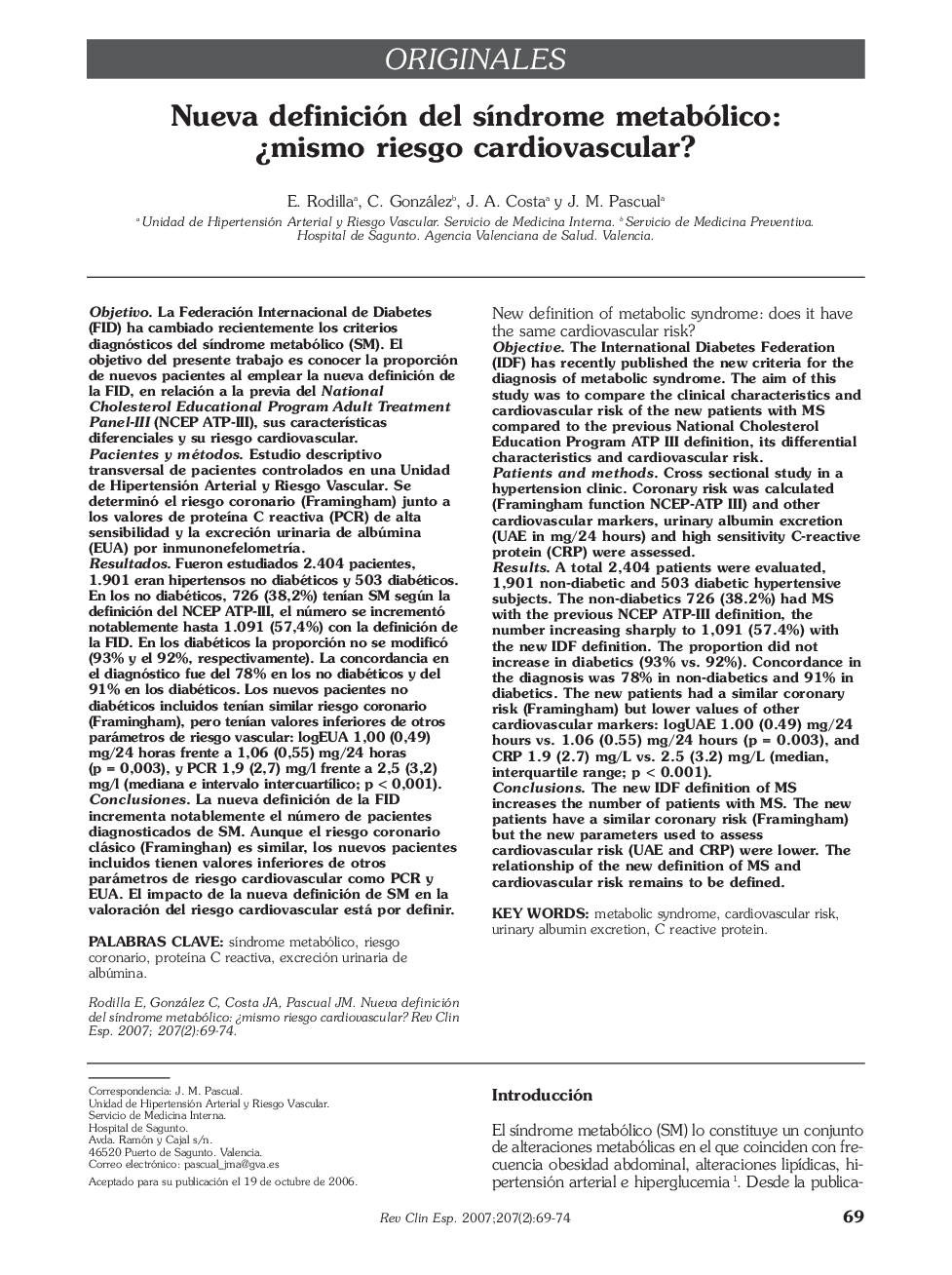| Article ID | Journal | Published Year | Pages | File Type |
|---|---|---|---|---|
| 3829813 | Revista Clínica Española | 2007 | 6 Pages |
ObjetivoLa Federación Internacional de Diabetes (FID) ha cambiado recientemente los criterios diagnósticos del sÃndrome metabólico (SM). El objetivo del presente trabajo es conocer la proporción de nuevos pacientes al emplear la nueva definición de la FID, en relación a la previa del National Cholesterol Educational Program Adult Treatment Panel-III (NCEP ATP-III), sus caracterÃsticas diferenciales y su riesgo cardiovascular.Pacientes y métodosEstudio descriptivo transversal de pacientes controlados en una Unidad de Hipertensión Arterial y Riesgo Vascular. Se determinó el riesgo coronario (Framingham) junto a los valores de proteÃna C reactiva (PCR) de alta sensibilidad y la excreción urinaria de albúmina (EUA) por inmunonefelometrÃa.ResultadosFueron estudiados 2.404 pacientes, 1.901 eran hipertensos no diabéticos y 503 diabéticos. En los no diabéticos, 726 (38,2%) tenÃan SM según la definición del NCEP ATP-III, el número se incrementó notablemente hasta 1.091 (57,4%) con la definición de la FID. En los diabéticos la proporción no se modificó (93% y el 92%, respectivamente). La concordancia en el diagnóstico fue del 78% en los no diabéticos y del 91% en los diabéticos. Los nuevos pacientes no diabéticos incluidos tenÃan similar riesgo coronario (Framingham), pero tenÃan valores inferiores de otros parámetros de riesgo vascular: logEUA 1,00 (0,49) mg/24 horas frente a 1,06 (0,55) mg/24 horas (p = 0,003), y PCR 1,9 (2,7) mg/l frente a 2,5 (3,2) mg/l (mediana e intervalo intercuartÃlico; p < 0,001).ConclusionesLa nueva definición de la FID incrementa notablemente el número de pacientes diagnosticados de SM. Aunque el riesgo coronario clásico (Framinghan) es similar, los nuevos pacientes incluidos tienen valores inferiores de otros parámetros de riesgo cardiovascular como PCR y EUA. El impacto de la nueva definición de SM en la valoración del riesgo cardiovascular está por definir.
ObjectiveThe International Diabetes Federation (IDF) has recently published the new criteria for the diagnosis of metabolic syndrome. The aim of this study was to compare the clinical characteristics and cardiovascular risk of the new patients with MS compared to the previous National Cholesterol Education Program ATP III definition, its differential characteristics and cardiovascular risk.Patients and methodsCross sectional study in a hypertension clinic. Coronary risk was calculated (Framingham function NCEP-ATP III) and other cardiovascular markers, urinary albumin excretion (UAE in mg/24 hours) and high sensitivity C-reactive protein (CRP) were assessed.ResultsA total 2,404 patients were evaluated,1,901 non-diabetic and 503 diabetic hypertensive subjects. The non-diabetics 726 (38.2%) had MS with the previous NCEP ATP-III definition, the number increasing sharply to 1,091 (57.4%) with the new IDF definition. The proportion did not increase in diabetics (93% vs. 92%). Concordance in the diagnosis was 78% in non-diabetics and 91% in diabetics. The new patients had a similar coronary risk (Framingham) but lower values of other cardiovascular markers: logUAE 1.00 (0.49) mg/24 hours vs. 1.06 (0.55) mg/24 hours (p = 0.003), and CRP 1.9 (2.7) mg/L vs. 2.5 (3.2) mg/L (median,interquartile range; p < 0.001).ConclusionsThe new IDF definition of MS increases the number of patients with MS. The new patients have a similar coronary risk (Framingham)but the new parameters used to assesscardiovascular risk (UAE and CRP) were lower. Therelationship of the new definition of MS and cardiovascular risk remains to be defined.
